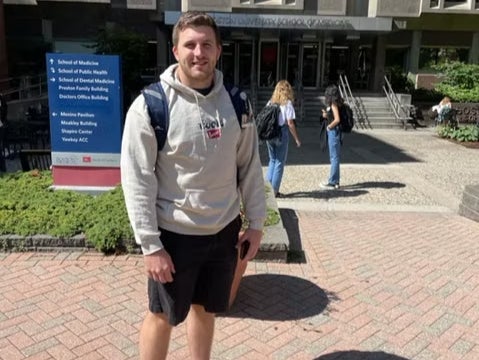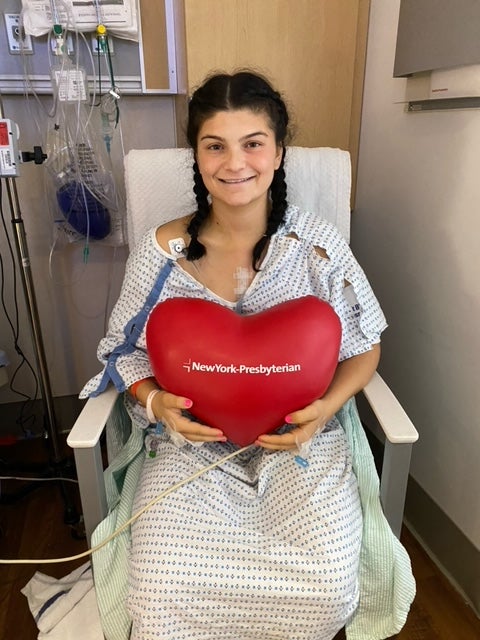
It’s perhaps not too surprising that Damar Hamlin, after suffering a cardiac arrest on the field, allegedly woke up to ask who won the game between the Buffalo Bills and Cincinnati Bengals.
When Long Islander Jack Crowley, then 15, took a line drive to the chest at the batting cage in 2015, he woke up confused and wanting to go back to sleep – only to find petrified adults standing around him near the field. When Fordham University softball player Sarah Taffet collapsed near home plate in 2021, she woke up feeling like she was underwater - then asked how far she’d hit the ball, wanting to return to the game.
They’d both, like Hamlin, suffered cardiac arrest after being hit in the chest. Information has not yet been released about the cause of the Bills star’s heart event, though many doctors have suggested that a condition called commotio cordis could have been the culprit. He was released from the hospital in Ohio on Monday, one week after his shocking collapse, and continues recovery at another facility at home in Buffalo, New York.
It was commotio cordis that stopped Mr Crowley’s heart in 2015. Doctors initially surmised commotio cordis in Ms Taffet’s cardiac arrest before further tests revealed an underlying, previously undiagnosed heart defect .
Regardless of Hamlin’s diagnosis, his terrifying on-field episode - and the medical speculation surrounding it - has drawn pinpoinoted attention to commotio cordis and sudden cardiac arrest, and survivors are keen to keep up that momentum. CPR and AED use saved both Mr Crowley and Ms Taffet, they say, begging the public to be vigilant that these events can happen anywhere, at any time, and everyone needs to be prepared.

“A public event like this really brings attention,” Mr Crowley tells The Independent, thrilled that Hamlin, like him, has survived cardiac arrest so well. “Everybody should know how to do CPR and AED. It’s so incredibly easy, and if you know how to do it, you can save a life. It’s not even you could save a life; it’s when will you save a life.”
Cardiac arrest, not to be confused with a heart attack, “is the abrupt loss of heart function in a person who may or may not have been diagnosed with heart disease,” according to the American Heart Assocation. “It can come on suddenly or in the wake of other symptoms” - whereas a heart attack is caused by a blockage to the heart.
More than 356,000 cardiac arrests occur outside a hospital in the US each year, the AHA reports.
Crowley and his family were at his brother’s baseball game in 2015 when he and another brother decided to play at the batting cages nearby.
“I threw a ball to him; he lined it back into my chest,” he says. “There was a third guy with us, our brother’s friend, who said, ‘Are you OK?’ I just said, ‘Yeah, I’m okay’ - and then I collapsed.”
His vision started tunneling, “but it happens very quickly,” he says. Luckily, there were two doctors and a nurse watching their kids play baseball nearby, as well as an off-duty police sergeant. They quickly sprung to action.
“I was unconscious, but they starte CPR and put the pads on me,” he says, administering “one shock - and after between three and four minutes, I was back. I had a pulse; I was breathing on my own. After about five, I was awake and talking. I did not want to go in the ambulance, because I didn’t really undestand what had happened.
“I didn’t really get the gravit of it until somebody explained to me, ‘Dude. You were clinically dead three minutes ago.’”
When he first woke up, he says, “I actually wanted to go back to sleep, which sounds awful, but I was in high school; it felt like my alarm clock going off at 6am. Then all of a sudden, I finally open my eyes and see all these people around me.”
He spent two days in the hospital before being released.
“They said no residual effects, nothing,” says Mr Crowley, who just graduated from Stony Brook University with a degree in biochemistry and pre-medical studies. He is currently studying at Boston University School of Medicine and is an EMT.

It was determined that he’d suffered commotio cordis, “a condition in which an abnormal heart rhythm (ventricular fibrillation) and cardiac arrest happen immediately upon an object (usually something small and hard like a baseball or hockey puck) striking the chest directly over the heart at a very critical time during a heartbeat,” according to the Cleveland Clinic.
“With commotio cordis (Latin for “agitation of the heart”), the impulse from the object disrupts the normal heart rhythm and leads to sudden cardiac arrest.”
The condition occurs when a hit lands directly over the heart “at the exact wrong location at the exact wrong timing” during the heart’s rhythm cycle, Dr. Rod Passman, director of the center for arrythmia research at Northwestern University’s Feinberg School of Medicine, told AP.
The location where the baseball hit Mr Crowley was “if you went to the very bottom of your sternum and went over the left about three or four inches,” he tells The Independent.
The condition is commonly seen in young male athletes, usually under 20, and only a few dozen cases are reported in the US each year. About 60% of those affected survive, heart rhythm specialist Dr. Mark Link of UT Southwestern Medical Center told AP.
The Fordham Softball player, however, was over 20 and a woman when she suffered a cardiac arrest first attributed to commotio cordis at a softball game in New Jersey in October 2021. Doctors found within weeks, however, that she had a heart defect from birth called ALCAPA.
The circumstances of her cardiac arrest were very similar to those of Hamlin’s and Mr Crowley’s; each of them seemed initially okay before collapsing.
Ms Taffet had just hit a ball to first base and was running to beat it before being tagged by a player on the other team.
“She tagged me; I kind of fell forward ... like I got the wind knocked out of me,” Ms Taffet tells The Independent. “I was out, so I started running off the field. And I just kind of remember my body like not being able to move and my eyes ... everything closing in on me.
“And then I remember not being able to breathe. I was like, ‘I don’t know what’s going on right now.’ I thought I was having a panic attack or something ... Everything was black, and I couldn’t see, and I just remember being like, ‘Why am I not being able to?’”

When her heart stopped, she collapsed and has no memory of that. Like Mr Crowley, she was lucky; there was a doctor and physician’s assistant present to perform CPR, and her athletic trainer grabbed an AED that successfully shocked her heart back into rhythm.
“I just remember waking up and like feeling like I was underwater for a long time,” she says. “I tried to catch my breath, breathing really heavily and just looking around and being so confused. Even when she was told her heart had stopped, she “didn’t comprehend exactly.”
She adds: “I even asked when I woke up, ‘Did I hit a home run? Where did I hit the ball?’”
Once in the ambulance, she remembers “wanting to go back out there and play,” Ms Taffet tells The Independent. Her mother mistakenly told her she’d hit the ball to third base, and “ that’s when it clicked on. Like, ‘Oh my gosh, I hit it to first base , I got a tag and that’s what happened. So my mom told me a wrong story, but that helped me to figure out what actually happened.”
After two days of tests that came back normal at the hospital, she says, she was told she could return to school but would require follow-ups.
One of her doctors “didn’t believe that it was commotio cordis solely,” Ms Taffet says. “You usually see that in younber boys and more contact sports, like soccer. I’ve gotten tagged in the chest harder than I did that day multiple times before in my career. It wasn’t dirty by any means; it was a harder hit, but not something to make someone’s heart stop ... so she really didn’t buy that there was solely commotio cordis. That’s why she did like the hundreds of tests after, because she wanted to really make sure - and I’m happy she did because she found out the cause.”
In general, underlying heart disease is the most common cause of sudden cardiac arrest, the AHA’s chief medical officer, Dr Mariell Jessup, told AP.
“It is not uncommon to find out that very vigorous athletes have undiagnosed cardiac conditions even if they’re young players,” she said.
Doctors found that Ms Taffet had undiagnosed ALCAPA, which stands for anomalous left coronary artery from pulmonary artery, and she was quickly in surgery on 1 November 2021. She was back playing softball by February, she says.
“I had open heart surgery and I didn’t miss a season,” she tells The Independent.
When Hamlin collapsed last week, however, her phone started blowing up.
“I got a bunch of texts,” Ms Taffet says. Her teammates were messaging to say: “Hey, hope you’re doing okay - it definitely brings us back to that game last year.”
Mr Crowley was at his family’s home on Long Island when his brother came downstairs and told him a football player had collapsed suddenly, as he had.
“I flipped the TV on and saw the replay,” he says, saying that it was “weird watching it on the other side.”
“I was very lucky, and it just kind of reminds me,” he says, adding: “It definitely brought back memories.”
A juvenile diabetic, he’d already wanted to be a doctor, he says - but his brush with death “definitely did gear me towards emergency medicine.”
“That’s hopefully the goal,” he says. “I’d love to work in an emergency room somewhere.”
In addition to studying medicine, he works to raise awareness and emphasises the importance, again, of knowing CPR, having an AED available and knowing how to use it. He knows that someday, as an ER doctor, he may end up treating patients just like him - and just like him, patients helped by knowledgeable bystanders.
“I hope by the time they get to me, they’ve already been shocked,” he says.







